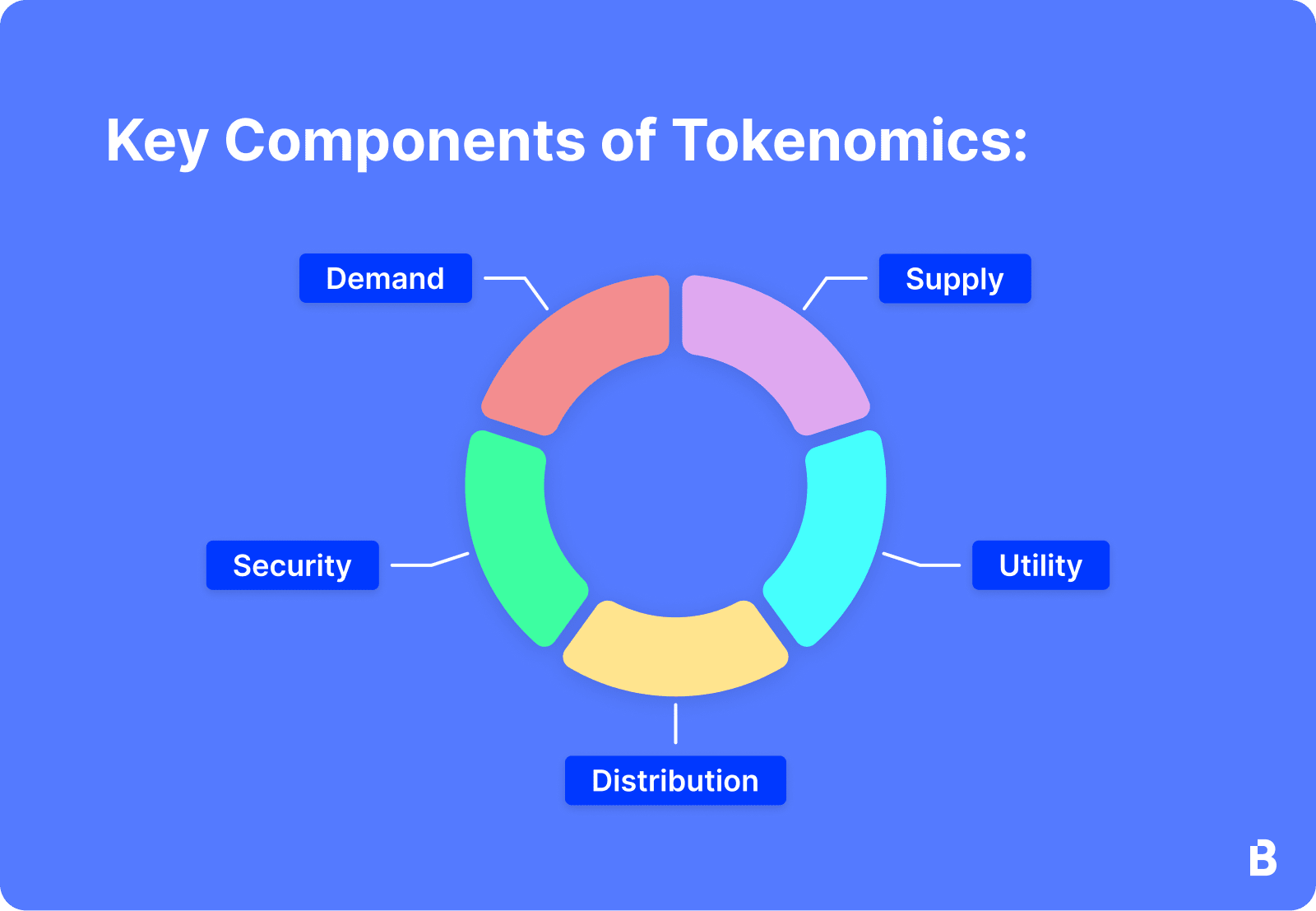When deciding which project is to be successful, economic foundations are just as important as the technology behind the scenes. This is where the function of tokenomics, or token economics, comes in. It represents the economic concept and incentive systems behind a crypto project, ultimately defining user adoption/incentives as well as investor incentives for long-term sustainability.
If you are an investor, developer, or just a crypto enthusiast, you will understand the crucial subject of tokenomics in anything that happens in the blockchain industry. From token supply models to distribution strategies, as well as utility utilization, governance stacking, and burn mechanics, the tokenomics of a project impact its real-world valuation & behavior.

This article breaks down the fundamentals: what is tokenomics, how it shapes a project's ecosystem, and insights into what you should pay attention to while assessing the economic foundation behind a digital product.
Tokenomics is a combination of the terms “token” and “economics”; it is the full description of financing sources organized as a list of economic and fair utilities. The document includes all the aspects that affect the price of a token, from supply to circulation and use case, along with distribution and market cap. This framework helps everyone, from users to investors, understand how the token works in its ecosystem.
Tokenomics describes the internal market dynamics of a project, in which supply and demand play the main role. These originate from factors such as token issuance, allocation, and user incentives that are fundamentally different from the design of traditional currencies that are subject to central bank and government monetary policy.
A token is a general-purpose digital asset that resides on an existing blockchain and is implemented by smart contracts. Cryptocurrencies run on their blockchains, while most tokens sit on top of popular public platforms like Ethereum, BNB Chain, or Solana.
Tokens can be used for a lot of things, from claiming ownership over physical assets to accessing certain features within a decentralized app. Alternatively, they may also be used to incentivize governance or staking behavior, for payments, or as non-fungible tokens (NFTs).

The economic model of a cryptocurrency, also known as the tokenomics, is critical in determining how much value it can capture and its long-term sustainability. It effectively functions to govern the ways in which a digital currency operates with respect to its supply and can have substantial (financial) implications on both distribution and utility. It is important for investors to understand the best tokenomics models before making an investment, as well as for developers to develop a healthy ecosystem and make it sustainable.
Here's why tokenomics matters:
For Investors:
For Developers:
In general, tokenomics shows how the supply of the token is maintained, fixed, capped, etc., and all inflationary/deflationary factors. The distribution of tokens among the team, early investors, and the public can have drastic effects on price and stability.
Tokenomics details how a cryptocurrency operates within its ecosystem. Rules are inbound on how tokens are originated, distributed, and in-circuit impact the conduct of users, token value, and long-run durability of the project. The economy you create for your token must balance supply and demand, be incentive-aligned (help your system grow), and be transparent (i.e., simple).

Here are the basic building things to take into account:
It refers to the way in which new tokens are introduced into the market, such as via mining, staking rewards, or predefined schedules in smart contracts. A controlled supply schedule prevents inflation and supports price stability in the long run.
In simple terms, token allocation is the distribution of tokens to your various stakeholders. The general and most common categories are founders and team members, investors (private & public), advisors and partners, community rewards, and treasury or ecosystem fund.
Strategic allocation provides resources for the project to grow and gives incentive to early adopters. Yet poor allocation is creating fairness and centralization worries.
Distribution is the way that tokens will be available in circulation as per the declared allocation. For example, this could happen instantly through airdrops, public sales, and liquidity mining. Or it will be incremental through staking reward/liquidity mining/task doing, etc.
The point of an effective distribution strategy is to drive user engagement, bootstrap network effects, and prevent large holders who could dump tokens and crash the price from accumulating excessively.
They can be confounding due to employing the use of a vesting schedule, which is simply locked-up tokens released over a period of time. They are made for founders and team members, early investors, and advisors.
This helps in reducing pump and dump behavior, since the agreed release time aligns incentives long-term. As noted, the 4-year vest is the norm with a 1-year cliff (no tokens for each of year one) and then monthly or quarterly distribution in years two through four.
Governance mechanisms are used in many crypto projects where token holders vote on changes, upgrades, or financial decisions. This can include:
By including governance tokens, it no longer had the ecosystem alone in control of the project, introducing decentralization to better accommodate new needs. Additionally, a few projects use on-chain governance as well, for the automation and transparency of decision-making.
This is one of the most important aspects that investors, analysts, and end-users may look at when analyzing a project. Strong tokenomics usually shows some level of both design and planning, meaningful unit economics for growth, and a well-thought incentive structure; all ingredients are essential if the goal is execution in the long term. On the flip side, weak or manipulative tokenomics can indicate unsustainable models or redemption schemes.
The very first thing one assesses while evaluating the tokenomics of a project is its economic sustainability. Key questions include:
A promising project will employ its token for actual utility (payments, governance, and staking), rather than just using it as a tool for raising capital. Viability also entails that the token distribution and rewards mechanisms do not create any long-term imbalances or promote short-term speculative behavior.
This is a fundamental rule of crypto investing: Do Your Own Research (DYOR). Before getting into any project, it is absolutely essential to scrutinize the tokenomics of the project in detail by:
Reading through the official documentation gives you a brief grasp on the structure of the token, where it fits in the ecosystem, and what plans they have from now on.
The truth is not all the information that you can find about crypto is accurate or objective. For a 360 perspective on the tokenomics of a project, get opinions from:
Getting insight from reliable sources keeps you away from biased stories or deceptive promotional materials, often on social media or shill posts.
Always verify claims of tokenomics against on-chain data and transparent documentation, as it's easy to make up dubious projections. Things to check include:
When you do that fact-checking, which is a test to confirm the behavior of the actual token with what the project has promised to deliver, it becomes easier for you to see some red flags.
Then, assess how the tokenomics helps to recognize the future of growth for the project. Consider the following:
A well-thought-out tokenomics crypto model does not only underpin the internal functioning of a project but also instills trust in its supporters.
Tokenomics is more than just some numbers. It can give you the ideas for planning a strategy, financial philosophy, or scaling the project. It is not just about hype; it's the science of supply dynamics, reward models, and incentive alignment in a crypto project. With further research and due diligence, investors can avoid potential risks and find more profits in the ever-changing world of cryptocurrency.
Let us consider several tokenomics examples, crypto with the best tokenomics models, and their supply mechanisms, incentives, and governance structures.
SUI by Mysten Labs is a high-performance Layer 1 blockchain stack with Move-based programming language.
Key tokenomics features:
The tokenomics of SUI prioritize decentralization and scalability, as well as actively rewarding participation. This is to prevent anything with short terms, like a pump and dump, with structured vesting and distribution schedules over years.
Ethereum Layer 2 rollup Arbitrum is the key to more scalable and cost-effective dApp development.
Key Ethereum tokenomics features include:
Arbitrum is a governance token, but it does not have any kind of utility as a transaction or gas. Utilizing a DAO-centric model, the community has authentic decision-making power in what is described as an industry trending toward decentralization.
As the first and most demanded coin, BTC is typically considered to have set the model for Bitcoin tokenomics, which also serves as the blueprint for decentralized monetary policy.
Key BTC tokenomics features are:
BTC developers constrained supply, and the halving trend makes the currency inherently deflationary. That scarcity is central to its narrative as "digital gold." It also has real-world proof-of-work consensus, which links security to energy expenditure.
Comparing Tokenomics Across Leading Projects